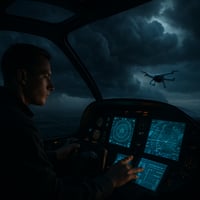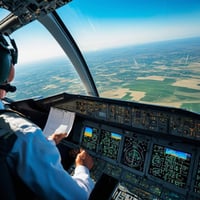Automation’s Hidden Threat: Why Overreliance on Drones and Autonomy May Be Aviation’s Greatest Risk...
Aviation Safety Under Threat? Examining Accident Trends, the 1,500-Hour Rule, Automation Dependency, and the Rush Toward Autonomous Aircraft
Aviation Safety Under Threat? Examining Accident Trends, the 1,500-Hour Rule, Automation Dependency, and the Rush Toward Autonomous Aircraft
Recent aviation accidents have raised serious concerns about the state of air travel safety. While aviation remains statistically one of the safest modes of transportation, troubling trends—including a rise in near-misses, declining pilot training quality, and overreliance on automation—suggest that cracks are forming in the industry’s safety framework. Historically, aviation regulations have been written in blood, reacting to disasters rather than preventing them. Now, as the industry pushes forward with automation and even autonomous aircraft, we must ask: Are we ignoring past lessons in our rush toward the future?
This article explores the recent accident trends, the consequences of the 1,500-hour rule, the degradation of flight training, and the industry’s increasing reliance on automation. It also examines whether we are moving too quickly toward pilotless commercial aircraft without ensuring that safety remains paramount.
Are Aviation Accidents Increasing? The Data Behind the Concern
While the overall number of fatal aviation accidents remains low, recent trends suggest that serious incidents and near-misses are becoming more frequent.
• The International Air Transport Association (IATA) reported a decline in total aviation accidents from 42 in 2022 to 30 in 2023, with the accident rate improving from 1.30 to 0.80 per million sectors.
• The National Transportation Safety Board (NTSB) reported a drop in U.S. civil aviation accidents from 1,277 in 2022 to 1,216 in 2023, with fatalities decreasing slightly.
However, these statistics do not tell the whole story.
The FAA recorded a 25% increase in near-miss incidents between 2022 and 2024, including over 300 documented cases of aircraft coming dangerously close to colliding on runways or in controlled airspace. Several high-profile accidents and close calls have raised alarms, such as:
• A runway incursion at JFK Airport in 2023 where an American Airlines jet nearly collided with a Delta plane at high speed.
• The Washington, D.C., midair collision in 2024, which ended the U.S.’s 15-year streak without a major fatal airline crash.
While aviation’s overall safety record remains strong, these near-misses and operational errors suggest a growing systemic issue that cannot be ignored.
The 1,500-Hour Rule: Has It Made Aviation Safer or Created New Risks?
The 1,500-hour rule was enacted in response to the 2009 Colgan Air Flight 3407 crash, which killed 50 people. This regulation requires pilots to accumulate 1,500 flight hours before obtaining an Airline Transport Pilot (ATP) certificate. While designed to ensure pilots have extensive experience before flying for airlines, the unintended consequences have arguably created new safety risks.
The Disappearance of Meaningful Entry-Level Jobs
Before the 1,500-hour rule, low-time pilots could build experience in Part 135 charter operations, cargo flying, aerial surveying, and bush flying. However, rising insurance minimums—which now often require pilots to have 2,000+ hours and turbine time—have eliminated these traditional stepping-stone jobs.
• Many Part 135 operators used to hire commercial pilots with 500 hours to fly twin-engine aircraft and turboprops. Today, most require 1,500+ hours, ATP certification, and significant turbine experience—requirements that prevent newer pilots from gaining valuable real-world experience.
• Aviation insurance companies now dictate hiring standards more than the FAA, requiring high experience levels even for relatively simple aircraft.
As a result, many pilots resort to time-building schemes, such as renting airplanes with other low-time pilots to artificially accumulate flight hours without meaningful operational experience.
The Flight Instructor Bottleneck: Are We Producing Weaker Pilots?
Since traditional low-time flying jobs are gone, most pilots now build their hours as flight instructors before moving to the airlines. However, this has led to a serious problem:
Are time-building CFIs (Certified Flight Instructors) harming the quality of pilot training?
• Most CFIs today are instructing solely to build hours, not because they are passionate about teaching.
• Instructor turnover is extremely high, meaning students often train under multiple different CFIs, leading to inconsistent instruction.
• Many CFIs have no real-world operational experience outside of their own training, so they teach students based only on what they were taught—without practical knowledge of actual airline or commercial flying.
This weakening of foundational pilot training creates a cycle of degradation, where today’s flight students become tomorrow’s airline pilots—without ever having been truly mentored by experienced aviators.
Symptoms of this problem include:
• Poor communication skills with ATC due to CFIs avoiding controlled airspace.
• Weak manual flying skills due to overreliance on automation even in basic training.
• A lack of real-world aeronautical decision-making experience.
If new airline pilots are the product of rushed, inexperienced instruction, is it any surprise that automation dependency and safety concerns are growing?
Automation and the Erosion of Pilot Skills
Modern aircraft are more automated than ever, with systems like TCAS (Traffic Collision Avoidance System), autopilot, autothrottles, and auto-land significantly reducing pilot workload. However, this automation has also degraded manual flying skills among some pilots.
The Evidence of Over-Reliance on Automation
• The 2013 Asiana Airlines Flight 214 crash in San Francisco occurred when pilots, accustomed to automated landings, mismanaged their approach and failed to recognize a dangerously low airspeed.
• The 2019 Boeing 737 MAX crashes of Lion Air Flight 610 and Ethiopian Airlines Flight 302 were caused by automation failures that pilots struggled to override, leading to fatal crashes.
If automation is replacing manual flying skills, what happens when the technology fails?
The FAA and NTSB have emphasized the need for pilots to regularly practice manual flying, but airlines increasingly favor automation-based procedures. This has resulted in pilots who meet the hour requirement but lack fundamental stick-and-rudder proficiency.
Are We Rushing Too Fast Toward Autonomous Aircraft?
Despite these issues, the aviation industry is racing toward pilotless commercial aircraft. Companies like Airbus and Boeing are developing AI-driven systems that could replace human pilots entirely.
Proponents argue that:
• Pilot error is the leading cause of accidents (69.1% of general aviation crashes, per FAA data).
• Removing pilots could reduce operational costs and mitigate pilot shortages.
However, automation failures have already contributed to multiple catastrophic accidents. If the industry rushes into autonomy without addressing these issues, we could be repeating past mistakes.
Regulations Written in Blood: Are We Ignoring Past Lessons?
Historically, aviation regulations have only been enacted after deadly accidents:
• The 1956 Grand Canyon mid-air collision led to the creation of Air Traffic Control (ATC).
• The 1977 Tenerife disaster (583 dead) led to major reforms in Crew Resource Management (CRM).
• The 2009 Colgan Air crash led to the 1,500-hour rule.
If history repeats itself, we may only recognize the dangers of over-automation after an AI-driven crash claims lives.
Conclusion: A Call for Balance and Caution
Aviation remains one of the safest industries, but complacency is dangerous. The 1,500-hour rule, lack of real-world experience for new pilots, degradation of flight instruction, and overreliance on automation are all contributing to safety concerns.
Before fully embracing autonomous aircraft, the industry must restore meaningful pilot training pathways, ensure instructors are truly preparing students, and balance automation with manual flying proficiency.
If aviation regulations are written in blood, we must ask ourselves: Are we setting up the next disaster by ignoring the warning signs today?



